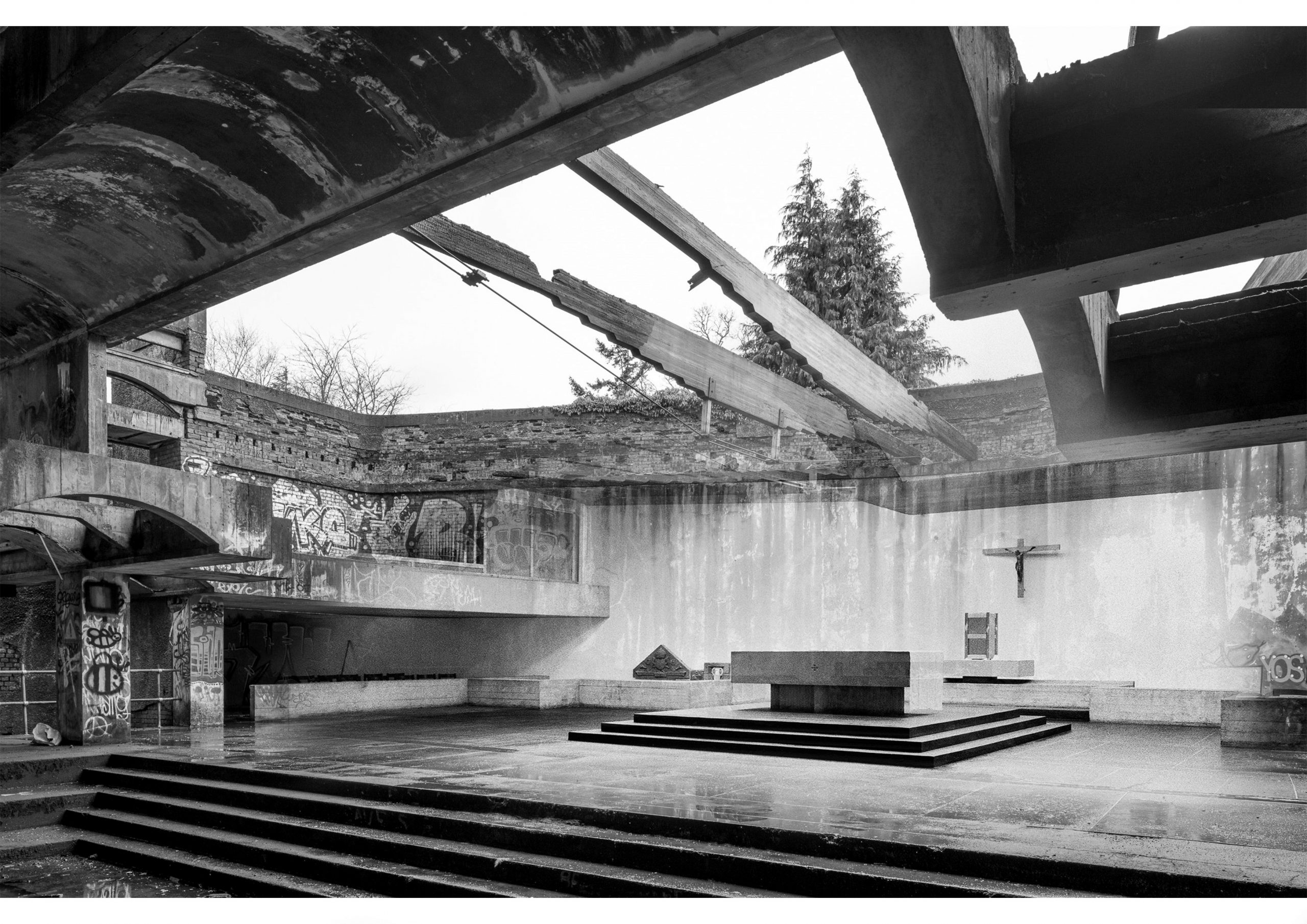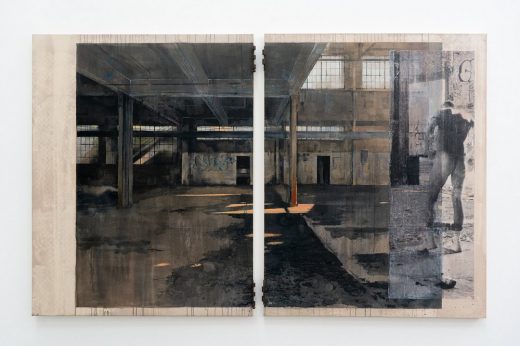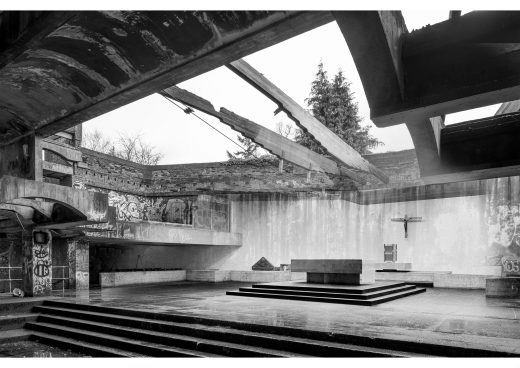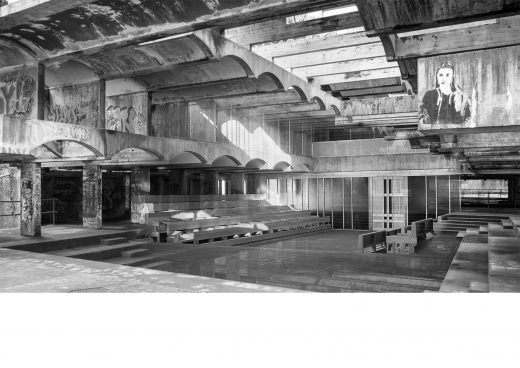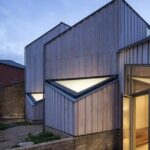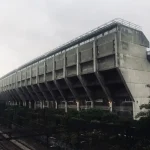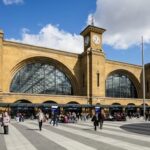Pleasure Scene, Trafalgar Avenue London Exhibition SE15, St Peter’s Seminary
Pleasure Scene Exhibition, Trafalgar Avenue London
post updated 19 May 2025
The Digital Culture of Contemporary Architectural Drawings
11 June – 25 July 2021
29 Trafalgar Avenue, London, SE15 6NP, England, UK
The inaugural exhibition at Trafalgar Avenue marks the culmination of an 18-month collaborative project bringing together nine artists from across the UK to respond to the iconic modernist ruin, St Peter’s Seminary, Scotland.
Acknowledging the longstanding fascination with St Peter’s, the project draws from and builds upon the interest of artists, architects, and anarchists alike.
28 May 2021
Pleasure Scene Exhibition
In February 2020, the group travelled to the west coast of Scotland to visit the seminary, to experience first-hand the skeletal remains of the vast concrete structure and document the significant monument in flux.
As we tentatively emerge from and begin to make sense of this surreal and unsettling chapter, the exhibition seeks to engage viewers with the seminary at a time when its own future remains uncertain, through the lens of a group of artists whose work embraces a range of approaches to image-making, from painting to printmaking, photography and film.
Reflecting both a moment in time pre-COVID and the artists’ personal and collective experiences over the course of the last year, the exhibition touches upon a number of intersecting themes, with temporality, isolation, and loss considered alongside the ephemeral, renewal, and the potentiality for other worlds.
The title Pleasure Scene borrows directly from the graffiti that adorns the seminary walls whilst referencing Rose Macaulay’s seminal text Pleasure of Ruins.
‘Pleasure Scene’ – view looking south towards altar:
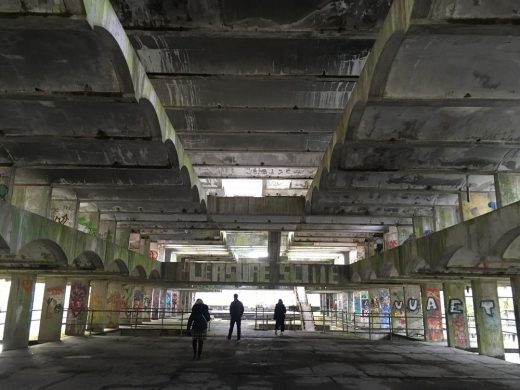
photo © Daniel Lomholt-Welch, 2019
Macaulay writes, “New ruins are for a time dark and bare, vegetationless and creatureless; blackened and torn, they smell of fire and mortality. It will not be for long. Very soon trees will be thrusting through the empty window sockets, the rose-bay and fennel blossoming within the broken walls, the brambles tangling outside them. Very soon the ruin will be enjungled, engulfed, and the appropriate creatures will revel.”
We are most grateful to the Hope Scott Trust for their generous support of this project. Lucy Schofield is a Scottish artist based in Edinburgh. She has a BA from Edinburgh College of Art (2005), an MA in Fine Art from the CASS School of Art (2015) and is a current postgraduate student on the Design for Cultural Commons MA at CASS School of Art.
In 2018 she founded 101 Henderson Row, a gallery and project space in Edinburgh’s New Town.
Lucy Schofield
Lucy Schofield is a Scottish artist based in Edinburgh. She has a BA from Edinburgh College of Art (2005), an MA in Fine Art from the CASS School of Art (2015) and is a current postgraduate student on the Design for Cultural Commons MA at CASS School of Art. In 2018 she founded 101 Henderson Row, a gallery and project space in Edinburgh’s New Town.
Michelle Avison
Michelle Avison is an English artist based in London. She has a BA in painting from the Slade School of Art (1988) and an MA in printmaking from Wimbledon College of Art (1994). She co-founded Slaughterhaus Print Studios in 2010 and is the head of the printmaking and bookbinding programme at Morley College.
Neal Gruer
Neal Gruer is a Scottish-Ghanaian photographer and writer based in Bucharest. He studied at Edinburgh University (2003-2007) and Université d’Aix-Marseille (2007-2008). He was a finalist on Sky Arts Master of Photography in 2016, and featured on 2019 BBC documentary, Black & Scottish. His recent publications include Same Difference / Aceeasi Diferentă, Does the Peacock Know…? and Encumbered Drum.
Estelle Vincent
Estelle Vincent is a French artist based in London. She holds a BA from Camberwell College of Arts (2005) and an MA from Goldsmiths (2010). She is the course leader in photography at Kingston College and short courses lecturer at the University of the Arts London and Morley College.
Dan Howard-Birt
Dan Howard-Birt is an English painter based between Cornwall and London. He is the director of Kingsgate Workshops & Project Space and makes exhibitions under the monikers LIDOprojects and World Service. He has a BA from Goldsmiths (1997) and an MA in Painting from the Royal College of Art (2002). He also teaches at Central Saint Martins, Camberwell College of Art, and Turps Art School.
Lara Davies
Lara Davies is a Welsh artist based in Cardiff. She has a BSc in Mathematics from Cardiff University (2010) and is a current postgraduate student on the MA Painting Programme at the Royal College of Art. In 2016, together with Casper White, she co-founded LLE Gallery, an artist-led curatorial project with a focus on contemporary painting.
Casper White
Casper White is a Welsh artist based in Cardiff. He has a BA from the Cardiff School of Art and Design (2003) and an MA from the University of Wales Trinity Saint David (2011). In 2016, he co-founded LLE Gallery with Lara Davies and in 2017 he was the recipient of the BP Travel Award.
Paul Dewis
Paul Dewis is an English artist based in London. He studied painting at the University of East London (1991-1993) and printmaking at the Slade School of Art (1994-1996) and currently teaches at Central Saint Martins and Morley College. In 2019 he won the Royal Society of Painter Printmakers prize.
Graham Martin
Graham Martin is a Scottish artist based in London. He studied at Edinburgh College of Art (2001-2003) and Edinburgh University (2003-2007) and is a current postgraduate student on the MA Painting programme at the Royal College of Art. He is a trustee at Kingsgate Workshops and Project Space and co-founder of Trafalgar Avenue
Exhibition Opening Event: Trafalgar Avenue
Free admission
The only architectural work in this exhibition aongisde the nine artists was by Daniel Lomholt-Welch, invited on the strength of his Third Year Dissertation.
Pleasure Scene Exhibition, Trafalgar Avenue London images / information received 280521
Contact details for Trafalgar Avenue:
info@trafalgaravenue.co.uk
@trafalgaravenue
+44 (0) 20 7277 4727
Location: 29 Trafalgar Avenue, London, SE15 6NP, UK
Dissertation on St Peter’s Seminary by Scottish architecture student Daniel Lomholt-Welch, Edinburgh
Preface
Growing up in a family of architects in central Scotland, it was nearly impossible to avoid the ghost of Gillespie Kidd & Coia, and the architecture that they proliferated across Scotland. In fact, I knew of Saint Peter’s Seminary well over a decade before I started at architecture school, and at least fifteen years before I started writing my dissertation. So, to say that this has been brewing for a while is perhaps an understatement.
I would firstly like to thank my supervisor, Dr. Dorian Wiszniewski, for his guidance, patience and encouragement during the project. I would also like to thank Adrian Welch and Dr. Jane Lomholt for their constant advice and support with proof-reading throughout the process. And finally, I would like to thank all of my family and friends, to whom this dissertation is dedicated.
This dissertation, much like its author, is steeped in sentimentality. The following piece of work is an attempt to plot a course not only through a building’s decaying matter, but through the sentiments that cling to it and the leaking theories that we would use to explain them.
Abstract
This dissertation is an ekphrastic journey through Saint Peter’s Seminary, the sentiments surrounding it, and the theories that attempt to bring definition to it. Previous research has hinted at the Seminary having a profound effect upon those who visit it, but has stopped short of actually investigating their experiences. By charting these experiences and exploring them in tandem with theoretical approaches to the space, it is hoped that the research can contribute a novel perspective of Saint Peter’s.
Introduction
Saint Peter’s Seminary is a building that is written about frequently, featuring in both the mainstream and architectural media regularly. So why write any more about it?
In this rhetoric lies the precise reason for doing so. Since its conception in the mid-20th century the Seminary has indeed been the subject of a variety of written works, ranging from brief articles in architectural magazines such as Prospect, to longer histories such as Diane Watters’ St Peter’s Cardross: Birth, Death and Renewal. However, what these discourses have arguably failed to engage with is the issue of why Saint Peter’s causes such debate in the first place. For some, it is an architectural masterpiece, for others it is an eyesore. For some, it is still hallowed ground, for others it forfeited any sacred qualities long ago. It is a building that gives rise to an extensive variety of experiences, and therefore holds a variety of meanings. This variation leads to another rhetorical question: which Saint Peter’s is being experienced?
The research focuses on this question, an issue which has had very little scholarly attention paid to it. This has dictated an approach which has combined material on the history and corporality of the Seminary with, on the one hand, theoretical material on the experience of space; and on the other, original first-hand accounts of Saint Peter’s. The theoretical material chosen is wide-ranging and attempts to investigate various aspects of the Seminary. Notions of plurality are scrutinised through Jean-Luc Nancy, before Martin Heidegger’s theory of ‘the fourfold’ is elaborated within the context of the Seminary. Mircea Eliade then provides a starting point for the discussion on the nature of sacred space, which is developed by Rudolf Otto’s concept of ‘the numinous’.
The primary source material, which forms the central empirical element of the work, firstly includes an ekphrastic composition of my own experiences of the Seminary, portrayed as a journey through the building itself. This is followed by a survey of a diverse range of those who have visited the Seminary, resulting in a broad spectrum of attitudes relating to Saint Peter’s.
Through the analysis of this survey certain correlations are brought to light regarding the proclivity of the space to induce certain reactions over others. Finally, interviews of Angus Farquhar, Ed Hollis, and Father Hugh Kelly were conducted in order to elucidate a more profound understanding of how the space is experienced. Each of these interviewees have differing relationships to Saint Peter’s, however all have a deep understanding and experience of the Seminary.
What this dissertation attempts to do is to frame Saint Peter’s in a way that gives consideration to the diversity of sentiments surrounding the building. By engaging with the perspectives of a multitude of those who have experienced the space in conjunction with some of the theories that work to define the space, it is hoped that an understanding of Saint Peter’s, or rather a series of understandings, can be conveyed.
Daniel Lomholt-Welch
Glasgow
02.12. 2020
Read the dissertation in full here: Daniel Lomholt-Welch dissertation on Saint Peter’s Seminary
London Architectural Designs
London Architecture Designs – chronological list
London Architect – design practice listing on e-architect
London Architecture Designs – architectural selection below:
Arbor Bankside Yards, Southwark, South London
Design: PLP Architecture
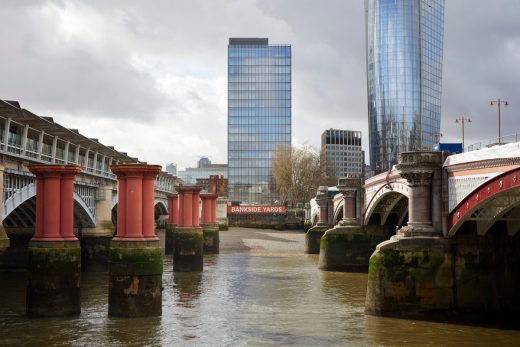
photo © Jack Hobhouse
David Hockney at Piccadilly Circus
Houses of Parliament Restoration and Renewal
NoMad London Hotel, Covent Garden
London Architecture Walking Tours
Roca London Gallery at Chelsea Harbour:
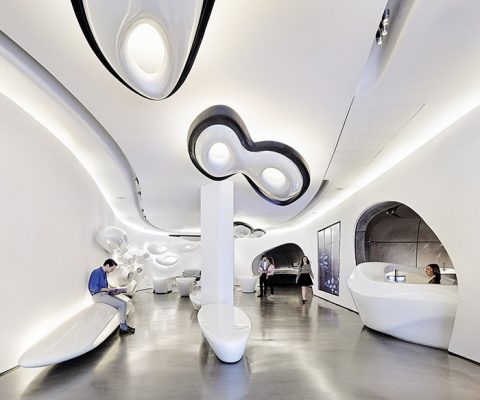
photo © Hufton+Crow
Comments / photos for the Pleasure Scene Exhibition, Trafalgar Avenue London page welcome
Website: www.rocalondongallery.com

